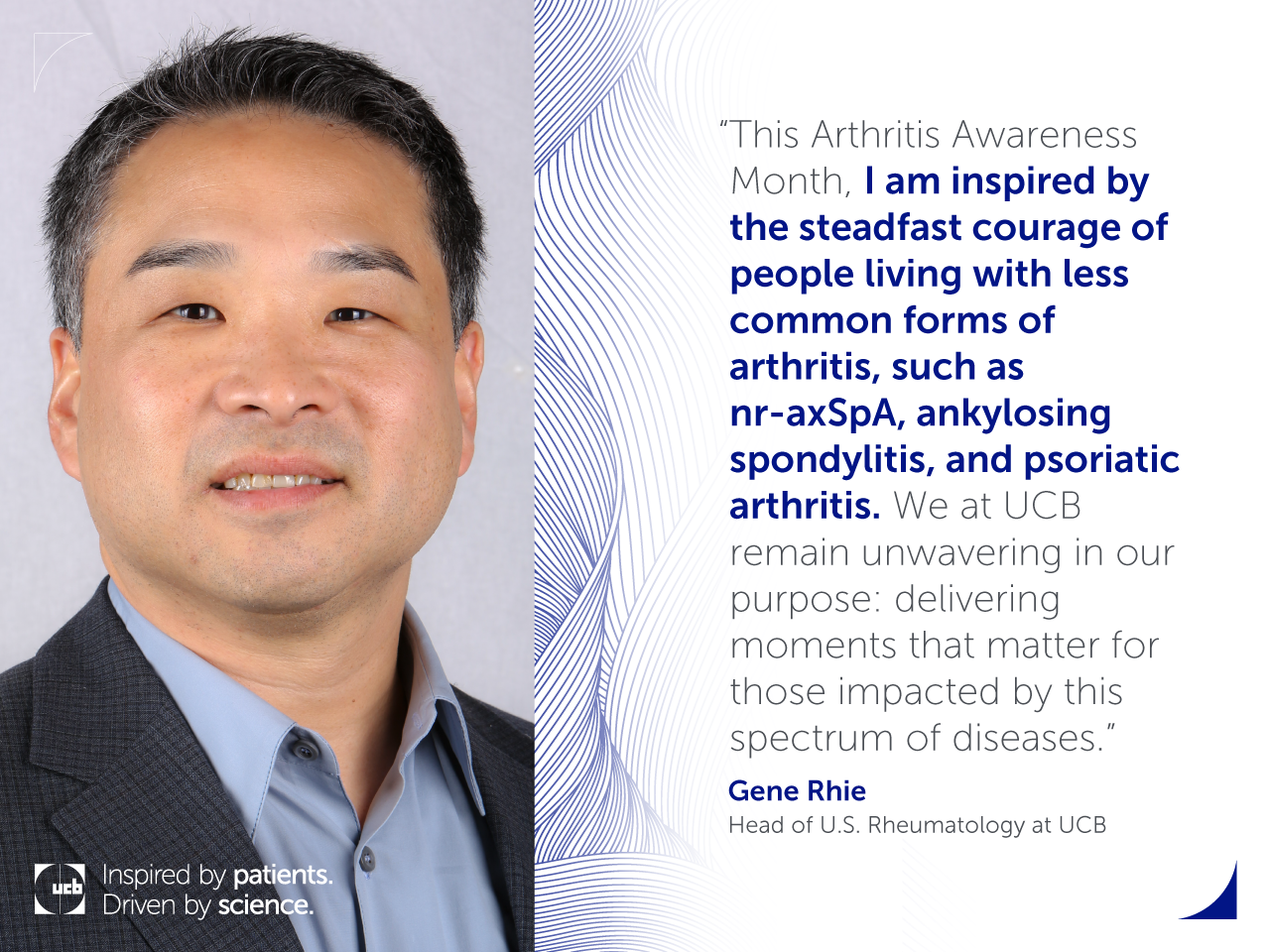
May is Arthritis Awareness Month – a time to recognize the more than 58 million Americans living with forms of arthritis and the significant toll this condition can have on their lives.1 With arthritis, there is typically inflammation or swelling of joints, but symptoms can differ markedly based on the type of arthritis and the individual.2 You may not be aware that while osteoarthritis and rheumatoid arthritis are among the most common types of arthritis, arthritis actually encompasses more than 100 different conditions.2
At UCB, we work to make meaningful improvements in the lives of people living with severe disease, now and in the future. And in my time at UCB, I’ve focused on understanding less common, but equally devastating, types of arthritis, such as non-radiographic axial spondyloarthritis (nr-axSpA), ankylosing spondylitis (AS) and psoriatic arthritis (PsA), and how to best help people impacted by these burdensome conditions.
Understanding nr-axSpA, AS, and PsA and Their Impact
Axial spondyloarthritis (axSpA) is a spectrum of inflammatory diseases, which includes nr-axSpA and AS. It is estimated as many as 3.3 million adults in the U.S. have axSpA. Within the axSpA spectrum of disease, the prevalence is split roughly equally between nr-axSpA and AS.3
AxSpA is characterized by inflammation in the joints that connect the pelvis and spine, known as the sacroiliac joints. With nr-axSpA, the damage does not appear on x-ray. As a result, it may take up to 10 years from symptom onset to diagnosis. Without a clear diagnosis or explanation for their symptoms, people with nr-axSpA are often left suffering in silence.
People living with axSpA often face a significant disease burden that includes substantial inflammatory back pain, prolonged and severe stiffness, fatigue, sleep disturbances, reduced physical function, decreased quality of life, impaired work and home productivity and limited social participation.3
PsA is an inflammatory musculoskeletal disease with both autoimmune and autoinflammatory features. PsA is typically characterized by inflammation, joint swelling and pain.4 It can have a diverse presentation not only affecting joints, but also involving skin, nails, tendons and ligaments.5 It is estimated that 1.5 million adults in the U.S. are living with PsA.6
Addressing the Unmet Need in Arthritis
People are at the heart of everything we do at UCB and we seek to understand the needs of those living with PsA and axSpA. Earlier this year, we heard from patients, physicians and patient advocates about their experience living with arthritis. We learned about the daily challenges people living with arthritis face in managing the physical symptoms and all that goes along with that: juggling visits to various doctors, balancing multiple medications in some cases, navigating insurance benefits – all of which add to the burden of the disease and impact quality of life.
The insights gleaned from patients inform our research and help us develop treatments to address their unmet needs.
Supporting the Whole Patient
One of the burdens many people living with severe disease face is navigating the healthcare system. Several years ago, we heard loud and clear from patients that one of the greatest challenges was around diagnosis of nr-axSpA. It was because of this insight that UCB worked in a collaborative effort to have nr-axSpA officially recognized in the classification system of diagnosis codes – or ICD-10 – and used within the healthcare system. This not only helps physicians appropriately code and classify a diagnosis, but also supports patient access to treatments and specific identification of their disease (rather than a category of diseases).
I am extremely proud of the continued hard work and commitment we at UCB have shown in helping people living with nr-axSpA, AS and PsA. Everyone deserves to live the best life they can as free as possible from the challenges and uncertainty of disease. Please join us as we raise awareness of these less common forms of arthritis– throughout the month of May and beyond.
1https://www.cdc.gov/arthritis/communications/features/arthritis-awareness.html
2https://www.cdc.gov/arthritis/types/index.html
3https://spondylitis.org/about-spondylitis/overview-of-spondyloarthritis/
4https://www.jrheum.org/content/89/7
5https://www.ncbi.nlm.nih.gov/pmc/articles/PMC6375462/
6https://www.hopkinsarthritis.org/arthritis-info/psoriatic-arthritis/
US-P-DA-RH-2200009
 |
|
 |
|
 |
|
Choose Country
- Global Site – English
- Australia – English
- België – Engels
- Belgique – Anglais
- Brasil – Português
- България – Български
- Canada – English
- Canada – Français
- 中国 – 中文
- Česká Republika – Angličtina
- Danmark – Engelsk
- Deutschland – Deutsch
- France – Français
- España – Español
- Ελλάδα – Ελληνικά
- India – English
- Ireland – English
- Italia – Inglese
- 日本 – 日本語
- Казахстан – ағылшын тілі
- 한국 – 한국어
- Luxembourg – Anglais
- Luxemburg – Engels
- Magyarország – Angol
- México & Latinoamérica – Español
- Nederland – Engels
- New Zeeland – English
- Norge – Engelsk
- Österreich – Deutsch
- Polska – Polski
- Portugal – Inglês
- România – Engleză
- Россия – Русский
- Slovensko – Anglický
- Suomi – Englanti
- Sverige – Engelska
- Schweiz – Deutsch
- Suisse – Français
- Türkiye – Türkçe
- Україна – Англійська
- United Kingdom – English
- U.S.A. – English